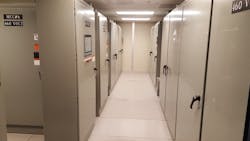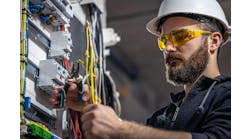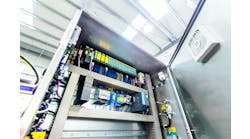Design basics of control enclosures in machines, automation and industry
Your PLC and control hardware will need a safe and secure home (Figure 1). The power distribution, safety system, contactors, relays, controllers and terminals need to be housed in the appropriate control enclosure and choosing one is not a simple task. There are many mechanical and control system requirements that must be met to get it right, and some of them are reviewed here.
It starts with a layout
On new designs, it is best to have a final or at least have preliminary electrical schematics and a parts list before specifying an enclosure. These documents help to create a panel layout drawing’s needed enclosure size. The layout should follow best practices by separating high-power and low-power components and the related electrical noise, along with grouping like components together and maintaining proper spacing between components for proper heat distribution.
Don't pack it all in a box; plan ahead, and future maintenance will be a better experience.
Figure 1:This bank of control enclosures houses more than $150,000 in control hardware controlling more than $30 million worth of equipment.
Source: Republic Services and Siemens
Where are you going to put it?
The location and function of the enclosure drive the design and form factor. There are many types of enclosures such as wall mount, free-standing, disconnect, rack, IT, consoles, operator interface, outdoor and hazardous location. There are also often requirements and specifications related to the enclosure placements depending on the application. Many configurations are available with a variety of names, so work carefully with the vendor regarding questions during specifying. Working with the mechanical designers or integration crew is also important, or the enclosure may not fit.
Also read: The essentials of effective cabinet planning
It's not uncommon to mount an enclosure on a wall between existing equipment. It is also often necessary to embed the enclosure in a machine frame, and the mechanical guys are not shy about giving the control enclosure as little room as possible. Reserve and confirm the space needed for the control system enclosure through proper design and reviews. Even details such as door clearance from the machine frame and surrounding equipment must be checked.
Safe and secure
Keeping the control hardware clean and dry is the primary function of the control enclosure, and much information is available online explaining NEMA and IP ratings. These ratings define the ability of the enclosure or related accessory to withstand harsh industrial environments. NEMA and IP ratings are similar in that both specify protection against ingress of solid foreign objects and liquids. NEMA also specifies protection against corrosive substances.
While IT enclosures may be installed in climate-controlled rooms where an open or NEMA 1 configuration is suitable, industrial environments are better suited for enclosures rated NEMA 12, 4 or 4X which are equivalent to IP54 and IP65 respectively with the NEMA 4X having protection from corrosion. Many options are available so understand the area classification, but don't skimp on the seal in industrial environments. Keep this in mind when specifying accessories for the enclosure such as a fan and bulkhead fittings, also.
[pullquote]Something as simple as a handle on a enclosure door can affect safety and protection of both personnel and hardware. Often, if door clamps are used, they are left loose allowing dust, oil and foreign materials to enter the enclosure. A variety of handles and latching mechanisms are available to allow quick access to the control panel but quickly seal the door shut.
Handles and disconnects with door interlocks and through-door disconnects also help to ensure personnel protection by providing lockout/tagout points and by inhibiting opening the door unless power is off.
Also read: How to enhance your existing controls infrastructure investment
Not only should the control hardware be protected from dirt and debris, but it must be protected from temperature extremes also. Many applications can have temperature issues due to heat generated internally in the enclosure or by ambient conditions, so cooling or heating thermal management options must be considered. A consistent and narrow range of temperature can help to improve the life expectancy of the control hardware.
A variety of thermal management equipment from temperature switches, fans and heaters to air conditioners, vortex coolers, heat exchangers and thermoelectric devices are available. Online tools are available to make selection of these thermal management components simpler. These devices are an integral part of enclosure design, so, when in doubt, you are probably going to need a fan. Just make sure to include an appropriate filter and properly maintain it.
It has to look nice
For years the battleship-gray enclosures have been used. They are the true battleships of the enclosure market and work well, but nice-looking equipment is half the battle in making sure your customer is happy. You might want to throw a little less gray color into your design, and light gray is a good starting point.
Many enclosures provided multiple surface treatments such as resistant oils, lubricants, machining emulsions and solvents to protect against corrosion. Some even use nanocoatings with surface particles arranged contiguously to help prevent fingerprints and make it easy to remove graffiti.
Plastic and stainless-steel enclosures also look great, but should be specified based on the environment. Plastic is cost-effective but can be easier to break or melt and provides limited EMI protection but great corrosion resistance, and it’s easy to cut. Stainless steel is more costly but provides greater protection and anti-corrosion capabilities, as well, but it’s difficult to cut.
Much customization is available from the leading suppliers of enclosures. Custom colors, enclosure sizes and cutouts are available through online vendor tools such as CAD data, CAE software, configurators, thermal analysis and even IT management software. Don't be afraid to go custom, make it look nice and reduce the work necessary by having cutouts provided by the enclosure manufacturer. Whether it is quantity of one or 300, get it sized properly, specified for the location and looking nice. It doesn't really cost more to do it right.
More from Control Design:
Learn how applying advanced computer-aided design to engineering and manufacturing can automate processes from design of power distribution, communication networks, I/O and panel layouts to a significant portion of control panel manufacturing.







